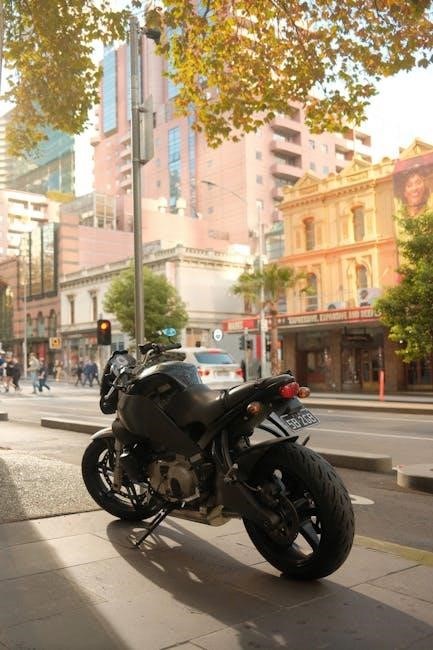Schwinn bikes, established in 1895, are iconic in cycling history, offering a blend of style, durability, and performance. Their value lies in timeless designs, historical significance, and enduring popularity among collectors and riders. Determining their worth helps enthusiasts and sellers appreciate their legacy and set fair market prices.
Understanding the Popularity and Historical Significance of Schwinn Bicycles
Schwinn bicycles have captivated cyclists for over a century, blending innovation, durability, and timeless style. Founded in 1895, Schwinn became synonymous with American cycling, influencing trends and setting standards. The introduction of iconic models like the Sting-Ray and Krate in the mid-20th century revolutionized youth cycling, while the Airdyne, launched in 1978, popularized air resistance training. Schwinn’s commitment to quality and design has made its bikes enduringly popular, resonating with both casual riders and collectors. Their historical significance and lasting appeal contribute to their value, making Schwinn a cornerstone in cycling culture and a sought-after brand for enthusiasts worldwide.
Why Determining the Value of Schwinn Bikes is Important for Collectors and Sellers
Determining the value of Schwinn bikes is crucial for both collectors and sellers to ensure fair transactions and informed decisions. Collectors benefit by understanding market worth to avoid overpaying, while sellers can set competitive prices. Accurate valuations also help in insurance and estate planning. With Schwinn’s rich history, models like the Sting-Ray and Krate hold sentimental and monetary value. Using tools like eBay and valuation guides, enthusiasts can research pricing trends, ensuring transparency in buying or selling these iconic bicycles. This process preserves the legacy of Schwinn bikes while fostering a vibrant market for enthusiasts.
Key Factors That Determine the Value of Schwinn Bikes
Condition, rarity, originality, and demand are critical in valuing Schwinn bikes. Models like the Sting-Ray and Krate often fetch higher prices due to their historical significance.
The Role of Condition and Originality in Assessing Value
The condition and originality of a Schwinn bike significantly impact its value. Bicycles in excellent condition with minimal wear and original parts, such as vintage frames or components, are highly sought after by collectors. Modifications or replacements of parts can lower the bike’s authenticity and, consequently, its value. Restored bikes are also valuable but must maintain originality to appeal to enthusiasts. A thorough inspection of the bike’s components, including paint, decals, and hardware, helps determine its worth. Originality ensures historical integrity, making well-maintained, authentic Schwinn bikes more desirable and valuable in the market.
How Rarity and Model Specifics Impact Pricing
The rarity of a Schwinn bike and its specific model features significantly influence its value. Limited production runs, unique designs, or special editions, such as the iconic Sting-Ray or Krate models, often command higher prices due to their exclusivity. Certain models, like the Paramount, are highly sought after for their craftsmanship and performance, driving up demand; Additionally, bikes with rare components, such as original chrome plating or vintage gearing systems, can increase value. Model-specific features, like the distinctive styling of the Schwinn Hornet or the lightweight frames of racing models, also play a crucial role in determining their market worth. Rarity and model specifics are key factors in pricing.
Market Demand and Trends in Vintage and Modern Schwinn Bikes
Market demand for Schwinn bikes varies between vintage and modern models, reflecting shifting trends in cycling culture. Vintage Schwinn bikes, particularly those from the 1940s to the 1980s, are highly sought after by collectors for their nostalgic appeal and craftsmanship. Models like the Sting-Ray and Krate have seen consistent demand, with restored versions fetching premium prices. Modern Schwinn bikes, including hybrid and electric models, attract fitness enthusiasts and commuters, offering affordability and reliability. Trends show a rise in interest for eco-friendly and home exercise bikes, such as the Schwinn IC4, which aligns with current lifestyle preferences. This dual demand drives the market for both classic and contemporary Schwinn bicycles.

A Brief History of Schwinn Bicycles
Founded in 1895 by Ignaz Schwinn, Schwinn bicycles quickly became synonymous with quality and innovation. The brand introduced the Airdyne in 1978, revolutionizing exercise bikes; Over the years, Schwinn has remained a trusted name, blending tradition with modern advancements to cater to diverse cycling needs.
Early Years and Evolution of Schwinn as a Brand
Founded in 1895 by Ignaz Schwinn, Schwinn bicycles quickly became a symbol of quality and innovation. The brand introduced groundbreaking designs, such as the Airdyne in 1978, which revolutionized exercise bikes. Over the decades, Schwinn adapted to changing cycling trends, producing iconic models like the Krate, Sting-Ray, and Predator, which dominated the mid-20th century. Known for their durability and style, Schwinn bikes catered to both recreational riders and serious cyclists, solidifying their reputation as a trusted name in the industry. This legacy continues to influence their modern designs, blending tradition with cutting-edge technology.

Iconic Schwinn Models Through the Decades

Schwinn’s legacy is marked by iconic models that defined eras. The 1940s-1980s saw the rise of the Krate, Sting-Ray, and Predator, beloved for their bold designs and durability. The Airdyne, introduced in 1978, became a staple in home fitness. More recently, models like the Sierra and IC4 have embraced modern trends, offering versatility for both mountain and indoor cycling. These bikes not only reflect Schwinn’s commitment to innovation but also hold sentimental value for collectors, making them highly sought after and influential in the cycling world. Their enduring appeal continues to drive interest among enthusiasts and investors alike.

Identifying Schwinn Bike Models and Years
Schwinn bike models and years can be identified through serial numbers, typically found on the frame, and by checking for originality and model-specific features.
How to Decode Schwinn Serial Numbers for Model Identification
Schwinn serial numbers are key to identifying bike models and years. Typically found on the frame, they often include codes for the model year and manufacturing details. Early Schwinn bikes (pre-1980s) used simple serial number systems, while later models incorporated more complex codes. By decoding these numbers, enthusiasts can determine the exact model, production year, and even the factory where the bike was made. Online resources and Schwinn-specific databases provide tools to interpret these codes accurately. This process is crucial for collectors and sellers to verify authenticity and determine the bike’s value effectively. Original components and matching serial numbers significantly impact the bike’s worth.

Key Features to Look for When Determining the Model Year
When identifying a Schwinn bike’s model year, focus on distinctive features like frame design, wheel size, and componentry. Early models often have unique styling, such as the iconic Schwinn Krate or Sting-Ray bikes from the 1960s and 1970s. Later models, like the Sierra or Predator, may feature suspension systems or modern upgrades. Check for serial numbers, decals, and original parts, as these can help pinpoint the era. Specific handlebar styles, seat designs, and brake systems are also telling. Cross-referencing with historical catalogs or online databases can provide accurate model year identification, ensuring authenticity and value assessment.

Using Online Resources for Schwinn Bike Valuation

Online platforms like eBay, specialized forums, and valuation tools provide detailed insights into Schwinn bike prices. These resources offer historical data, market trends, and user reviews to help determine accurate values, ensuring informed decisions for buyers and sellers.
Guide to Bicycle Valuation Tools and Websites
Bicycle valuation tools and websites are essential for determining Schwinn bike values. eBay is a top platform for comparing prices and researching recent sales of similar models. Specialized sites offer detailed guides, while forums and communities provide insights from enthusiasts. Tools like Bike Blue Book and The Pro’s Closet offer comprehensive valuations based on condition, rarity, and demand. These resources help collectors and sellers establish fair market prices, ensuring informed transactions and maximizing value for both parties. Using these tools effectively requires understanding how condition, originality, and market trends impact pricing.
How to Research and Compare Prices on Platforms Like eBay
Researching Schwinn bike prices on eBay involves using specific keywords like “vintage Schwinn” or “Schwinn [model name]” to find relevant listings. Filter results by condition, year, and location to narrow down comparisons. Check completed listings to see what similar bikes have sold for recently. Use the “sold items” filter for accurate pricing data. Compare multiple listings to identify average price ranges and trends. Pay attention to bike condition, originality, and rarity, as these significantly impact value. Detailed descriptions and high-quality photos can help verify authenticity and condition. This research helps determine fair market value and set competitive prices for buyers or sellers.
Tips for Selling Your Schwinn Bike
Clean and restore your Schwinn bike to enhance appeal. Provide clear photos and detailed descriptions of condition and features. Research similar models to set a competitive price. Be honest about any flaws or repairs to build trust with potential buyers. Highlight original parts and rare features to attract collectors. Consider listing on platforms like eBay or specialized bike forums to reach a broader audience. Timing your sale during peak cycling seasons can also increase interest and offers.
How to Determine a Fair Price for Your Schwinn Bicycle
To determine a fair price for your Schwinn bike, start by researching similar models on platforms like eBay or specialized bike forums. Compare completed listings to gauge market demand. Consider the bike’s condition, rarity, and originality, as these factors significantly impact value. Classic Schwinn models from the 1940s to 1980s are highly sought after by collectors, often commanding higher prices. Use online valuation tools or guides to estimate your bike’s worth based on its model, year, and condition. Keep in mind that basic models in decent condition typically range from $300 to $500, while rare or restored bikes can fetch much higher prices. Be transparent about any repairs or modifications to ensure a fair and honest sale.
Preparing Your Bike for Sale: Restoration and Presentation Tips
Restoring your Schwinn bike before sale can significantly boost its value. Start with a thorough cleaning to remove dirt and grime, and considertouching up any rust spots. Replace worn-out tires, chains, and brakes to ensure it’s road-ready. Highlight original features like chrome details or vintage decals, as these appeal to collectors. When presenting, use high-quality photos showcasing the bike from multiple angles. Include close-ups of serial numbers, logos, and any unique components. Write a detailed description, noting its condition, rarity, and any restoration work. Consider listing it on platforms like eBay, where you can compare prices and attract serious buyers.

The Collector’s Guide to Rare Schwinn Bikes
Rare Schwinn bikes, like the iconic Krate and Sting-Ray models, are highly sought after by collectors. Their value often lies in their historical significance, unique features, and limited production runs. Collectors should focus on models from the 1940s to the late 1980s, as these eras produced some of the most valuable bikes. Understanding the rarity and condition of a Schwinn bike is crucial for determining its worth. Additionally, researching serial numbers and historical trends can help collectors identify rare gems and make informed investment decisions.
Identifying Rare and Vintage Schwinn Models
Identifying rare and vintage Schwinn models involves examining unique features, such as chrome finishes, distinctive frame designs, and specific components. The Sting-Ray and Krate series, popular in the 1960s and 1970s, are highly sought after. Look for models with original parts, including Schwinn-approved accessories, as these retain higher value. Serial numbers can also help determine the production year and model. Vintage Schwinn bikes often fetch premium prices due to their historical appeal and limited availability. Collectors should research extensively to authenticate rare models and ensure they are in good condition, which significantly impacts their market value and desirability.

Investing in Schwinn Bikes: What to Look For
When investing in Schwinn bikes, prioritize models with historical significance, rarity, and excellent condition. Focus on iconic and limited-edition bikes, such as vintage Sting-Rays or Krate series, which are highly sought after by collectors. Ensure the bike retains original parts and components, as these significantly enhance value. Research market trends and recent sales data to gauge demand and potential appreciation. Consider the bike’s authenticity by verifying serial numbers and consulting Schwinn archives. Additionally, evaluate restoration costs and potential, as a well-restored bike can yield higher returns. Understanding these factors helps make informed investment decisions in the Schwinn market.
